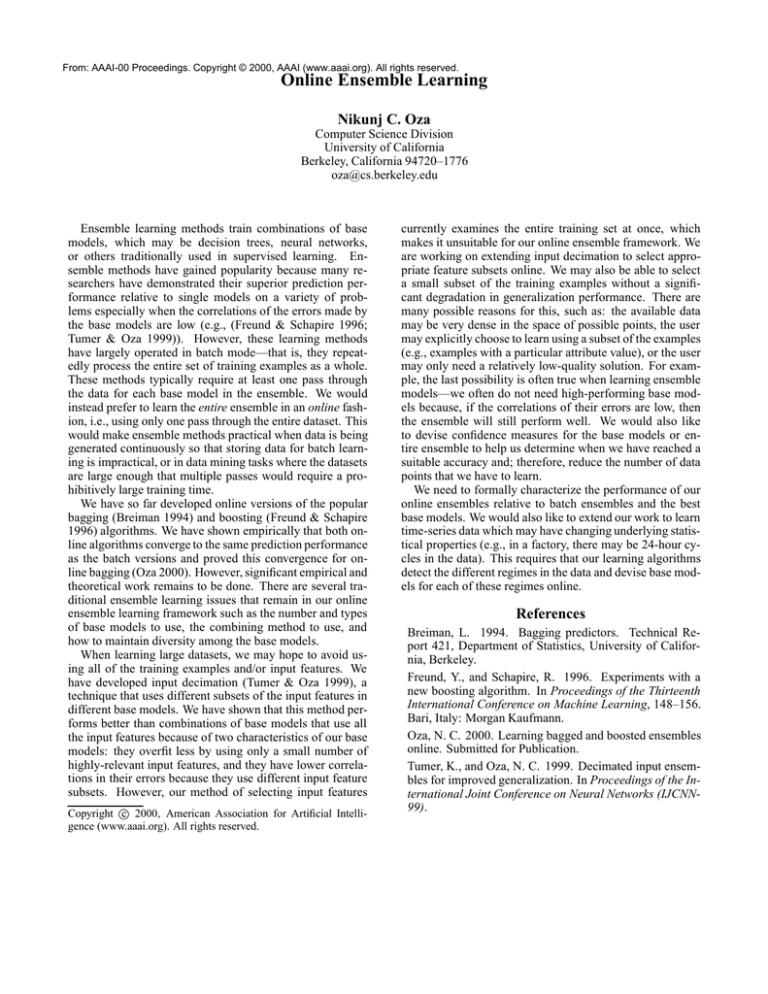
From: AAAI-00 Proceedings. Copyright © 2000, AAAI (www.aaai.org). All rights reserved.
Online Ensemble Learning
Nikunj C. Oza
Computer Science Division
University of California
Berkeley, California 94720–1776
oza@cs.berkeley.edu
Ensemble learning methods train combinations of base
models, which may be decision trees, neural networks,
or others traditionally used in supervised learning. Ensemble methods have gained popularity because many researchers have demonstrated their superior prediction performance relative to single models on a variety of problems especially when the correlations of the errors made by
the base models are low (e.g., (Freund & Schapire 1996;
Tumer & Oza 1999)). However, these learning methods
have largely operated in batch mode—that is, they repeatedly process the entire set of training examples as a whole.
These methods typically require at least one pass through
the data for each base model in the ensemble. We would
instead prefer to learn the entire ensemble in an online fashion, i.e., using only one pass through the entire dataset. This
would make ensemble methods practical when data is being
generated continuously so that storing data for batch learning is impractical, or in data mining tasks where the datasets
are large enough that multiple passes would require a prohibitively large training time.
We have so far developed online versions of the popular
bagging (Breiman 1994) and boosting (Freund & Schapire
1996) algorithms. We have shown empirically that both online algorithms converge to the same prediction performance
as the batch versions and proved this convergence for online bagging (Oza 2000). However, significant empirical and
theoretical work remains to be done. There are several traditional ensemble learning issues that remain in our online
ensemble learning framework such as the number and types
of base models to use, the combining method to use, and
how to maintain diversity among the base models.
When learning large datasets, we may hope to avoid using all of the training examples and/or input features. We
have developed input decimation (Tumer & Oza 1999), a
technique that uses different subsets of the input features in
different base models. We have shown that this method performs better than combinations of base models that use all
the input features because of two characteristics of our base
models: they overfit less by using only a small number of
highly-relevant input features, and they have lower correlations in their errors because they use different input feature
subsets. However, our method of selecting input features
Copyright c 2000, American Association for Artificial Intelligence (www.aaai.org). All rights reserved.
currently examines the entire training set at once, which
makes it unsuitable for our online ensemble framework. We
are working on extending input decimation to select appropriate feature subsets online. We may also be able to select
a small subset of the training examples without a significant degradation in generalization performance. There are
many possible reasons for this, such as: the available data
may be very dense in the space of possible points, the user
may explicitly choose to learn using a subset of the examples
(e.g., examples with a particular attribute value), or the user
may only need a relatively low-quality solution. For example, the last possibility is often true when learning ensemble
models—we often do not need high-performing base models because, if the correlations of their errors are low, then
the ensemble will still perform well. We would also like
to devise confidence measures for the base models or entire ensemble to help us determine when we have reached a
suitable accuracy and; therefore, reduce the number of data
points that we have to learn.
We need to formally characterize the performance of our
online ensembles relative to batch ensembles and the best
base models. We would also like to extend our work to learn
time-series data which may have changing underlying statistical properties (e.g., in a factory, there may be 24-hour cycles in the data). This requires that our learning algorithms
detect the different regimes in the data and devise base models for each of these regimes online.
References
Breiman, L. 1994. Bagging predictors. Technical Report 421, Department of Statistics, University of California, Berkeley.
Freund, Y., and Schapire, R. 1996. Experiments with a
new boosting algorithm. In Proceedings of the Thirteenth
International Conference on Machine Learning, 148–156.
Bari, Italy: Morgan Kaufmann.
Oza, N. C. 2000. Learning bagged and boosted ensembles
online. Submitted for Publication.
Tumer, K., and Oza, N. C. 1999. Decimated input ensembles for improved generalization. In Proceedings of the International Joint Conference on Neural Networks (IJCNN99).





